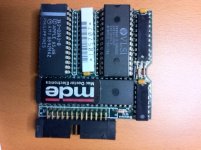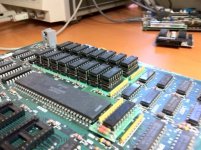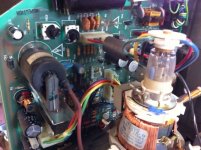bigmessowires
Well-known member
Woohoo! I've got a working Mac 512K, my first Mac in over a decade!
I purchased the 512K system yesterday from a woman who recycles electronics. It booted to the question-mark disk icon, but she didn't have any disks so there was no way to test it further. Being in semi-unknown condition, I was able to get it cheaply.
My next task was to create a 400K disk with System 4.1, which is the newest this Mac will run. I went to a nearby electronics surplus store, dug around through every box and barrel, and scrounged up 11 double-density disks suitable for 400K/800K Mac use. Then I borrowed a friend's SE/30, planning to use it to create the 400K disk for the Mac 512K.
Somehow I thought the SE/30 had ethernet, which it definitely doesn't, so now I had a new task to get the disk image to the SE/30 somehow. I planned to write the 400K disk image .dsk file to a 1.4MB high-density floppy from a PC, read that with the SE/30, and then use it to create the 400K System 4.1 disk. But the SE/30's floppy drive was flaky-- it wouldn't recognize that a floppy was inserted unless I first ran Norton Disk Doctor. Huh?
I then encountered a more fundamental obstacle-- none of the PCs I own actually have a floppy drive. So I went to a large computer/electronics store, and asked where I could find a floppy disk drive. The youngish store employee looked baffled. A what? After a few exchanges back and forth, he admitted "I don't know what that is." I can understand they might not sell them anymore, but to not even know what a floppy disk is??? Now I feel old.
Ran back to the surplus electronics store, and pulled an old floppy drive from a pile in a dingy cardboard box. Got it installed in my PC, only to find I don't have a 3.5 inch drive sled in my PC case, so I left it dangling loose. After many false starts, I finally discovered that the program WinImage will write Mac 1.4MB floppies from .dsk files. So I finally established all the links in my chain of computing technologies reaching from the present back to 1984. Wow.
I was ready to create the 400K System 4.1 disk, when I noticed that the Mac 512K has a SCSI port, labelled "Brainstorm SCSI", that looked like an upgrade. I grew suspicious that this Mac 512K had been upgraded to a Plus-like configuration, and so decided to try making an 800K System 6.0.8 disk first. Made a 1.4MB 6.0.8 disk on the PC, put it in the SE/30, waved some dead chickens to force the SE/30's flakey floppy to work, and copied the 6.0.8 disk contents to the hard disk. Then inserted a DD floppy, waved more dead chickens, and copied an 800K subset of the 6.0.8 startup disk to the DD floppy. Finally put the 800K floppy in the Mac 512K, and... Happy Mac!
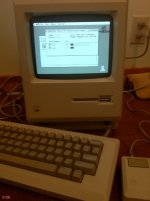
Clearly this 512K has been upgraded. It obviously has an 800K drive, since it read my 800K boot disk. Once I was able to boot it, I discovered that it has 1MB RAM. And there's that SCSI port-- I don't have anything to test it with, but I assume it's not just ornamental. I don't know if this was the official Apple upgrade path from the 512K to the Plus, or some aftermarket upgrade. Once I get the tools to open the case, I'll take a peek inside and see what I can learn.
Here's a photo of the back panel, showing the blue "Brainstorm SCSI" connector above the power switch:
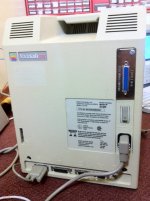
I purchased the 512K system yesterday from a woman who recycles electronics. It booted to the question-mark disk icon, but she didn't have any disks so there was no way to test it further. Being in semi-unknown condition, I was able to get it cheaply.
My next task was to create a 400K disk with System 4.1, which is the newest this Mac will run. I went to a nearby electronics surplus store, dug around through every box and barrel, and scrounged up 11 double-density disks suitable for 400K/800K Mac use. Then I borrowed a friend's SE/30, planning to use it to create the 400K disk for the Mac 512K.
Somehow I thought the SE/30 had ethernet, which it definitely doesn't, so now I had a new task to get the disk image to the SE/30 somehow. I planned to write the 400K disk image .dsk file to a 1.4MB high-density floppy from a PC, read that with the SE/30, and then use it to create the 400K System 4.1 disk. But the SE/30's floppy drive was flaky-- it wouldn't recognize that a floppy was inserted unless I first ran Norton Disk Doctor. Huh?
I then encountered a more fundamental obstacle-- none of the PCs I own actually have a floppy drive. So I went to a large computer/electronics store, and asked where I could find a floppy disk drive. The youngish store employee looked baffled. A what? After a few exchanges back and forth, he admitted "I don't know what that is." I can understand they might not sell them anymore, but to not even know what a floppy disk is??? Now I feel old.
Ran back to the surplus electronics store, and pulled an old floppy drive from a pile in a dingy cardboard box. Got it installed in my PC, only to find I don't have a 3.5 inch drive sled in my PC case, so I left it dangling loose. After many false starts, I finally discovered that the program WinImage will write Mac 1.4MB floppies from .dsk files. So I finally established all the links in my chain of computing technologies reaching from the present back to 1984. Wow.
I was ready to create the 400K System 4.1 disk, when I noticed that the Mac 512K has a SCSI port, labelled "Brainstorm SCSI", that looked like an upgrade. I grew suspicious that this Mac 512K had been upgraded to a Plus-like configuration, and so decided to try making an 800K System 6.0.8 disk first. Made a 1.4MB 6.0.8 disk on the PC, put it in the SE/30, waved some dead chickens to force the SE/30's flakey floppy to work, and copied the 6.0.8 disk contents to the hard disk. Then inserted a DD floppy, waved more dead chickens, and copied an 800K subset of the 6.0.8 startup disk to the DD floppy. Finally put the 800K floppy in the Mac 512K, and... Happy Mac!

Clearly this 512K has been upgraded. It obviously has an 800K drive, since it read my 800K boot disk. Once I was able to boot it, I discovered that it has 1MB RAM. And there's that SCSI port-- I don't have anything to test it with, but I assume it's not just ornamental. I don't know if this was the official Apple upgrade path from the 512K to the Plus, or some aftermarket upgrade. Once I get the tools to open the case, I'll take a peek inside and see what I can learn.
Here's a photo of the back panel, showing the blue "Brainstorm SCSI" connector above the power switch:


